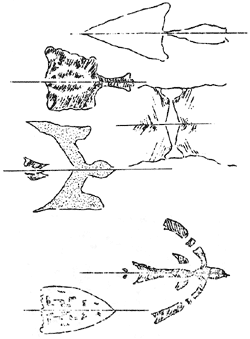|
Volume VI No. 2 - July, 1933
The Lake And Moods Of May
By David LeC. Evans, Ranger-Naturalist
March, it is said, comes in like a lion and departs like a lamb, but
at Crater this year it has continued like the proverbial lion until the
last few days of may. These last few days have brought out the fact
that nowhere can spring be more glorious than up here above the
snowline.
This combination of perdition and heaven, climatically speaking, has
revealed the lake in two very distinctive moods. The numerous
unfortunates who arrived before this return of spring were lucky to see
the lake at all, for as it snowed and rained, banks of vapor and cloud
were whipped down into the huge caldron, hiding from view the then
turbulent waters of the lake. Let us consider the description of this
phase sufficient, despite its briefness. It is the stormy and
disappointing mood.
On the other had, those fortunate who have been viewing the lake
during this last week of May, have departed with a picture never to be
forgotten. Standing on the top of a fifteen foot snowbank, they gaze,
in the brilliant sunlight, into a gigantic blue mirror, set in sloping
frame of glistening white, spotted with tints of green, red and brown.
There are two Wizard Islands, a duo of Hillman Peaks, massive Llao Rock
stands majestically, capped with a white, musing over its reflection in
the blue waters at its base. Not a breath of air stirs, and all is
silence except for the distant 'swish' of sliding snow. Only on such a
day could Joaquin Miller have called this the "Silent Sea".
As interesting as the lake, itself, are the snowbanks at the water's
edge and their reflections. It takes little imagination to see that the
base of Dutton Cliff a series of very ornate arrows, unfortunately, not
pointing towards true north but due east.....

A perfect butterfly of the swallow tail variety, perfect in every
detail, spends the entire day, floating easterly below Cloudcap, but is
ever stationary.....
Our Wineglass of the eastern end of the lake stand erect, and then
"bottoms up" on the blue-clothed table.....
For a person of geological mind, the imagination runs rife. A great
creature of the Mesozoic period is seen flying south, an Ichthyosaur
(what a name!) with a triangular head and great expanse of wing.
A gigantic fish of ancient vintage (Paleozoic) pursues friend
Pterosaur, but can never cut down that constant gap that separates
them.....
The ornate arrows suggest the early Indian visitors to Crater Lake,
as does the upper half of a war shield of very intricate and detailed
design.
In conclusion, such stillness leas to that common question, "What,
the lake is never coated over with ice? How very strange," Invariably
the answer is concluded "- - - but occasionally there is a slush ice."
We could give as the reason for this lack of ice two factors: (1) In a
deep lake the later at the surface, as it approaches the freezing point
become heavier and sinks. The warmer water beneath rises and this
continuous vertical circulation assists in preventing the formation of
ice at the surface; and (2) the ever present winter storms keep the
surface in such a state of agitation, that ice cannot form. This last
week in may has made the latter pint a strong one, for during this cold
week, still weather, a definite slush ice has been observed on the
surface, in the early morning.
Red Snow
By E. L. Clark, Ranger Naturalist
The blood-red snow fields of the Arctic, the red snow storms of
tradition, and the red snows of the high Cordillera have made their
appearance at Crater Lake.
On July 3 pink splotches on the snow covering the pumice flat in
front of the Lodge. July 5 similar areas were noted on the snow
partially blanketing the lava flows near the Witch's Pool on Wizard
Island. July 8 the phenomena was noted on the high slopes of Castle
Crest, the western portion of Garfield Peak.
Scraping away the upper portions of these pink splotches, one finds
the coloration intensified. A great abundance of tiny red spheres will
be fond as the coloring matter when examined under a high magnification.
These red spherical masses are algae, known to scientists as
Protococcus nivalis, meaning earliest snow-dwelling plant.
| 
